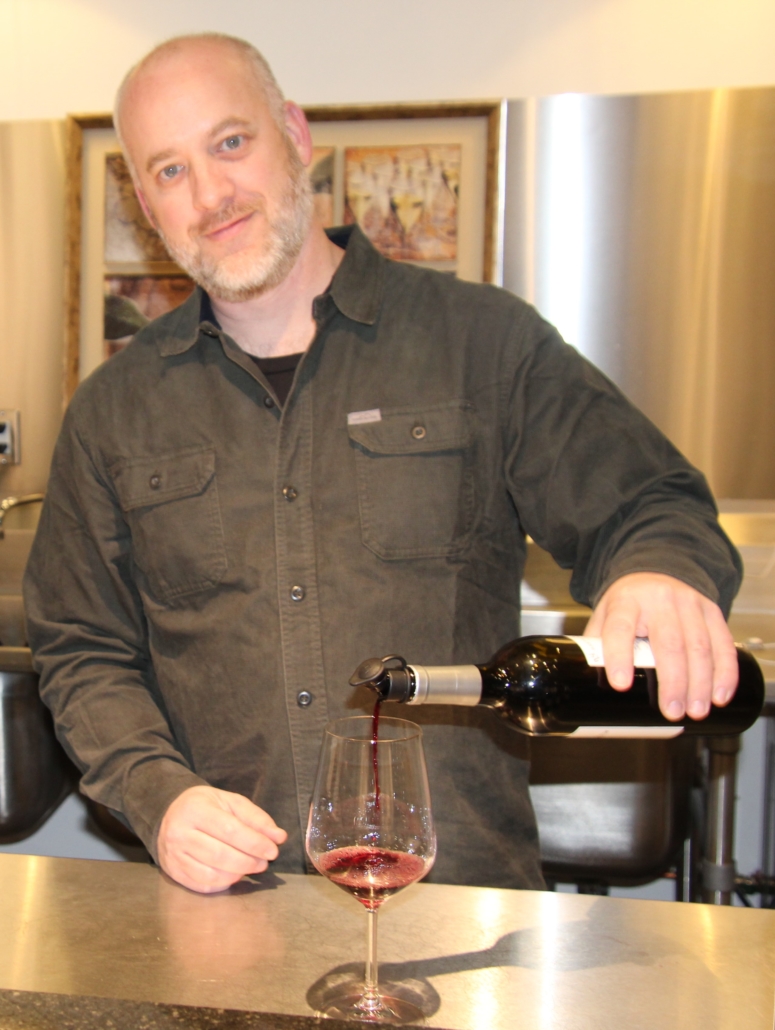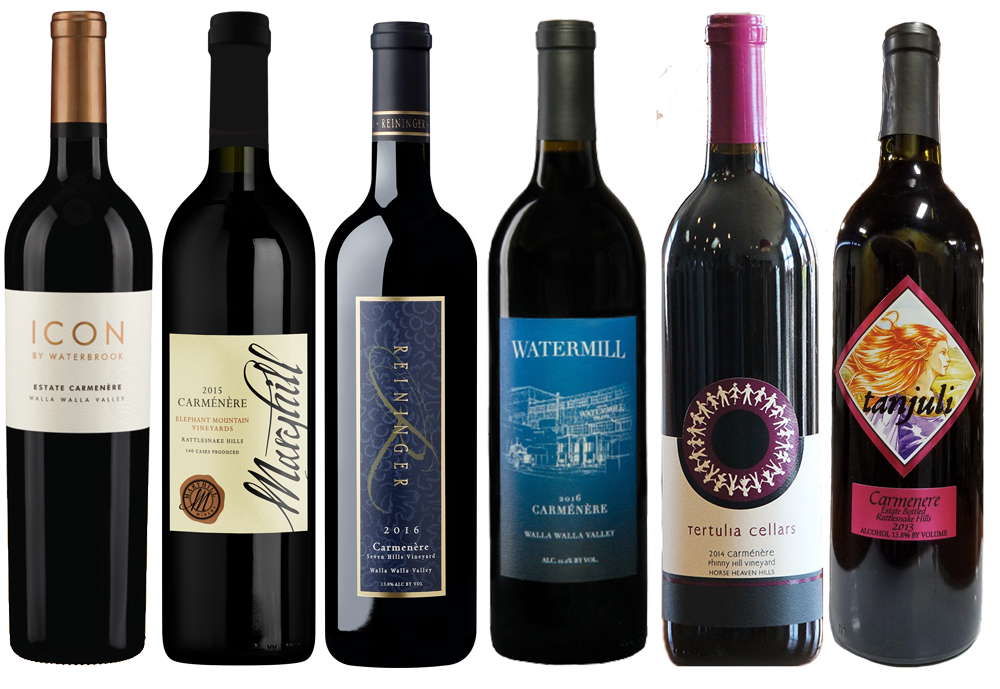Nearly extinct Carménère grape is alive and well in Washington State
Hot, dry climate in a handful of Eastern Washington AVAs makes for perfect growing conditions for this emerging varietal.
By Ken Robertson
For a wine grape that was believed to be virtually extinct for at least a century, Carménère is proving to be remarkably resilient. And in Washington state, it appears to offer greater versatility and complexity than wine history had suggested.
Within the last decade, it’s begun emerging as an intriguing newly planted grape that’s mostly being grown in small blocks, and so far makes up but a tiny fraction of Washington’s roughly 60,000 acres of wine grapes.
In fact, the Carménère acreage total is so small that’s it’s lumped into “other reds” during the state’s annual wine grape census. It’s sprinkled here and there in plots of mostly five acres or less, with plantings in several American Viticultural Areas, including Red Mountain, Walla Walla, Horse Heaven Hills, Yakima Valley and Rattlesnake Hills.

If there’s a Washington winemaker who’s truly fallen in love with Carménère, it’s probably Bart Fawbush of Bartholomew Winery. At his Kennewick, WA., production facility, Fawbush produces wines made from 100% Carménère. a red blend called Cuvée Rouge that leads off with 50% Carménère and a rosé of Carménère. Photo by Ivory Leininger.
Carménère was dubbed Bordeaux’s “lost grape” in the late 1800s, after phylloxera, a root louse, nearly destroyed the vineyards of France between 1860 and 1880. Even today, nearly a quarter century after DNA testing in the 1990s discovered a peculiar Chilean Merlot was actually the long-lost Carménère, many wine drinkers have not encountered it.
Virtually all the wine grapes of France, according to Larousse Wine, nearly perished with the arrival of phylloxera. It originated in the Western Hemisphere and was brought to Europe in the 1850s by avid botanists returning home with interesting New World plants. The nearly microscopic insect attacks not only the leaves and stems of grape vines, but also, most devastatingly, the roots during its larval stage.
During the decades of that losing battle with the bug, the French also lost the Franco-Prussian War of 1870-71, with nearly 140,000 men killed in six months. Then four decades later, World War I killed another 1.3 million French soldiers and wounded 4.2 million more between 1914-18. Those losses devastated the manpower French agriculture and many vineyards relied on by the time peace arrived on Nov. 11, 1918.
Through all the shelling and gassing, the nasty root louse persisted, gradually spreading throughout Europe. Just a few isolated areas in France, Spain and Italy remained free of the devastation. Gradually, resistant rootstock from North American vines was developed, grafted onto canes from European vines and became a staple of replanted vineyards.
In addition, French hybrids — crosses of New and Old World vines — were developed after World War I, with some of the better-known being Marechal Foch, named after the great French general of that war, Leon Millot and Baco Noir, all of which also are grown in the Pacific Northwest.
New problems emerged when American grape growers brought grape plants back from Europe in the less regulated times after Prohibition, and the nasty insect arrived on the West Coast. It has been a problem in California and also in some Oregon vineyards in the decades since. Washington apparently has escaped so far because our dry weather and sandy soils east of the Cascade Mountains appear to be a deterrent.
Still, the tiny bug inspired scores of laws, rules and regulations to keep rootstock free of it, resulting in disease-free rootstocks that now are carefully propagated under closely controlled growing conditions.
By the early 2000s, Carménère vines became available to Washington grape growers, and experimentation began. Del Long, a grape grower who lives just off the Yakima River between Prosser and Benton City, planted and began tending his first Carménère vines soon after they became available.
In the years since, he’s found it to be a vigorous vine that needs careful tending to manage its leafy canopy, but that it’s hardy and thrives in Washington’s climate in his area of the Yakima Valley.
As Long and other growers began to grow the new varietal, our state’s more adventurous winemakers began to take notice. Long himself has tinkered at making wines from his grapes, but mostly aims to sell the fruit to wineries.
When Long ordered enough grape vines to plant his five acres, the folks at Inland Desert Nursery near Benton City joked that he soon would be the largest Carménère grower in the state. More than a decade later, few growers have larger blocks of it.
On Red Mountain, the Williams family, owners of Kiona Vineyards & Winery, have five or six acres in their Heart of the Hill Vineyard, and Neil Cooper of nearby Cooper Winery expects soon to have up to seven to eight acres in production.
In the Walla Walla AVA, Seven Hills Vineyard has a planting similar in size to Kiona’s, and in the Horse Heaven Hills, there’s Phinny Hill Vineyard. Reininger, Waterbrook, Seven Hills and Beresan all have used Seven Hills fruit. Among the foremost proponents of Phinny Hills is Idaho winemaker Coco Umiker, whose Phinny Hill Carménère is a regular award-winner.
Speaking of award winners, Bob Delf, owner of Northwest Cellars in Kirkland, WA., has been making Carménère wine since 2007. His 2012 Carménère was judged “Best of Class” in Sunset Magazine’s competition, which is open to wineries worldwide, scored 91 points in judging by Wine & Spirits Magazine, and won a Double Gold medal at the Seattle Wine Awards. Delf sources all of the grapes for his Carménère wines from Phinny Hill and Kiona Vineyards. You can purchase his 2014 vintage of Carménère by visiting his tasting room in Kirkland or purchase it on line from his website: www.northwestcellars.com.
In the Rattlesnake Hills AVA, Elephant Mountain Vineyard grows small amounts of Carménère, with Maryhill Winery and winemaker Richard Batchelor among the best-known producers using its grapes.
If there’s a Washington winemaker who’s truly fallen in love with Carménère, however, it’s probably Bart Fawbush of Bartholomew Winery. Fawbush recently expanded from his former base in the old Rainier Brewing complex in south Seattle to downtown Kennewick, using it for all his winemaking for the 2018 crush.
He produces wines made from 100% Carménère, a red blend called Cuvée Rouge that leads off with 50% Carménère and a rosé of Carménère. With his Seattle tasting room and the new operation in Kennewick to supply, he’s expanding his production from his previous 2,000 cases and seeking out new grape sources as well.
For 2018, he’s using three vineyards, Seven Hills, Kiona’s Heart of the Hill and a third in the Rattlesnake Hills, which likely makes him one of Washington’s most geographically diverse Carménère makers. The source for his rosé has been the Rattlesnake Hills. The sources for his 100 percent Carménère and his red blend are chiefly Kiona and Seven Hills.

Fawbush said he believes the key to making good Carménère is to ensure the fruit is totally ripe. Since Carménère tends to ripen even later than the notoriously late Cabernet Sauvignon, that means it’s usually best not to pick until at least mid to late October.
Fawbush speculates that one of the reasons the French saved their other red varieties at the expense of Carménère might be that it often did not ripen sufficiently in Bordeaux. Especially in the late 1800s, when many summers were cooler than normal, it likely made for herbaceous wine laced with green pepper aromas and flavors.
In Washington in the 21st century, that’s not a problem because recent summers repeatedly have set heat records. Red wine grapes from Red Mountain, Washington’s warmest AVA, routinely are fully ripe, have plenty of sugar, manageable tannins and are lush from abundant hang time.
The result usually is a rather versatile wine that’s redolent with cracked black pepper, dark berry fruit aromas and flavors and maybe a little dash of herbs and green pepper. It pairs well with lamb, a nicely seared steak or a Dutch oven pot roast with potatoes and carrots.
Carménère may have had to move several thousand miles west by way of the Southern Hemisphere for its recent revival in the Northern Hemisphere, but because Washington shares its latitude with France, the grape is settling right in among our state’s vineyards. The next decade or so should determine whether this persistent survivor is here to stay.
EDITOR’S NOTE: Ken Robertson, retired editor of the Tri-City Herald, has been sipping Washington wine and writing about it since 1978. He also works as a wine judge throughout the Northwest.
 Readily Available Carménère Wines
Readily Available Carménère Wines
Following is a list of several of Washington’s wineries that offer highly regarded versions of Carménère made from the state’s amazing fruit that our young Carménère vines are producing. This listing is not comprehensive because Washington now has almost 1,000 wineries at last count. It includes Carménère wines that are readily available.
Because most wineries make only small lots of Carménère, check their websites or call for availability before you head out to taste them. Some wineries sell out quickly, some sell their Carménère only to wine club members and at least one maintains a list of eligible buyers. Prices listed are either as listed by the winery, or, if a wine has sold out at the winery, as listed by retail sources.
Fear not if something has sold out. A new vintage usually is released within a few months.
AntoLin Cellars — 2015, 100% Estate Carménère, $30.25; You can buy this wine at the winery’s tasting room at 14 N. Front Street, Yakima, WA. Or buy it directly from the winery’s online store at: www.antolinecellars.com. (509) 961-8370.
Bartholomew Winery — 2014 Red Mountain Carménère, $35; 2017 rosé of Carménère, $18; 2015 Cuvée Rouge, (a blend of Carménère, Cabernet Sauvignon, Cabernet Franc, Malbec, Petit Verdot and Merlot). Two locations: 421 E. Columbia Drive, Kennewick; tasting room, 3100 Airport Way S, Suite 10, Seattle, www.bartholomewwinery.com.
Beresan Winery — 2014 Carménère, $40; 4169 Peppers Bridge Road, Walla Walla, www.balboawines.com.
Cooper Winery — Contact the winery to learn how to join its customer list to obtain its 2015 Carménère; 35306 N Sunset Road, Benton City, www.cooperwinecompany.com.
Maryhill Winery — 2015 Elephant Mountain Carménère, $33; Two locations: 9774 WA-14, Goldendale; tasting room, 1303 W Summit Parkway, Suite 100, Spokane, www.maryhillwinery.com.
Northwest Cellars — 2014 100% Carménère (Phinny Hill and Kiona Vineyards), $48; 11909 124th Ave. N.E., Kirkland, WA. www.northwestcellars.com.
Otis Kenyon Wine — 2014 Carménère, Horse Heaven Hills, $40, mostly sold out, but some may remain at high-end wine shops. Two locations: 23 E. Main St., Walla Walla; tasting room: 14525 148th Ave. NE, #111, www.otiskenyonwine.com.
Reininger Winery — 2016 Seven Hills Vineyard Carménère, available only through its wine club. Two locations: 5858 Old Highway 12, Walla Walla; tasting room: 824 W. Sprague Avenue, Spokane. www.reiningerwinery.com.
Seven Hills Winery — 2016 Seven Hills Carménère, $35. This wine sold out last fall, but the new 2017 vintage will be available at the winery and at wine shops that specialize in Northwest wines by March lst; 212 N. Third Ave., Walla Walla (the old Whitehouse Crawford building), www.sevenhillswinery.com.
Tanjuli Winery — 2013, 100% Carménère, $38; 209 Bonair Road, Zillah, WA. You can buy this wine directly from the winery by calling owner Tom Campbell at (509) 654-9753, or by e-mailing him at: tanjuli@gmail.com. www.tanjuli.com.
Tertulia Cellars — 2014 Phinny Hill & Red Mountain Carménère, $48. Three locations: 1564 Whiteley Road, Walla Walla, tasting rooms, 1326 Highway 99 N, Suite #104, Dundee, Or., 19255 Woodinville-Snohomish Rd. NW, Unit 4, Woodinville, WA. www.tertuliacellars.com.
Waterbrook Winery — 2016 ICON Carménère, $38; 10518 W Highway 12, Walla Walla, WA. www.waterbrook.com.
Watermill Winery — 2016 Walla Walla Valley Carménère, $30; 235 E. Broadway Ave., Milton-Freewater, Or., www.watermillwinery.com.



